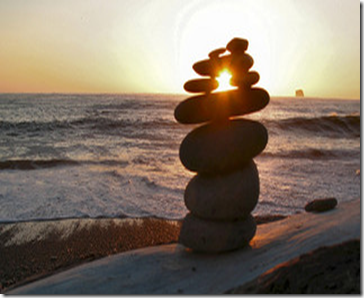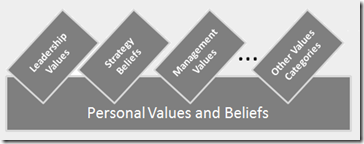 [Part 1] [Part 2] [Part 3] [Part 4] [Part 5]
[Part 1] [Part 2] [Part 3] [Part 4] [Part 5]
I hope part 1, 2, 3, and 4 have been helpful in providing motivation and a framework for examining your own beliefs and values. This post is about Balance and Lifestyle – two things that help hold values and beliefs together in you.
The content I provided is not intended to become your own foundation, although you are welcome to adopt any part that fits for you. Instead it is intended to ignite your thinking and begin to start your own habit of self-examination of your own values and beliefs. It’s an exercise that has huge upside, and no downside.
The idea to build this approach to sharing my own insight came from Stanford’s Bob Sutton – by reading his blog. I can’t take credit for the idea to share it, only my perspective and content. Bob has written a post on each item in his own list of “12 things he believes” (see the left column of his blog home page). It inspired me to write down what I believed, and it began to evolve into the categories for the first 4 parts of this blog series. While my Dad was a Stanford grad, and many times I have walked the campus, I don’t know Bob Sutton, but I like his work. I’m giving credit where it is due.
My Values and Beliefs Categories
 While I wrote the posts in reverse order, I think it was effective to peel back the layers from the outside in in order to examine what we observe in strong leaders, managers, and individuals we admire around us. From the bottom up, these values can be summarized as follows.
While I wrote the posts in reverse order, I think it was effective to peel back the layers from the outside in in order to examine what we observe in strong leaders, managers, and individuals we admire around us. From the bottom up, these values can be summarized as follows.
Personal values and beliefs are about you. They are your moral and ethical foundation. They are your being’s individual personal internal compass. They guide you in your day to day decisions, actions and interactions. They are the foundation for your own professional leadership, strategy and management values and beliefs.
Strategy beliefs are about goals. They constitute how you logically and methodically will get things (projects and tasks) done. It is around strategy beliefs that you form initial plans and the steps to move something forward. Initial strategy is the baseline you have to pivot to a new strategy when external influence and discovery drives a change.
Management values and beliefs are about projects. They help you balance expectations with risk and measure results. They are your approach to listening and communicating as you set expectations. They help balance the steps outlines in strategy against individual and aggregate risk. These values put truth to what is measured in results and outcomes. Regular rebalancing enables greater achievement – if you put the team first.
Leadership Values and Beliefs are about people. They involve your personal internal compass but are specifically focused on how you trust, inspire, lead, motivate and treat people around you. These values and beliefs determine if people will trust you back, and allow you to lead them. Or, alternatively, lack of values and beliefs could determine if others will undermine you as you charge ahead to execute strategy with no buy-in.
Build and strengthen your values through reflection, writing them down, and thinking about them when there is no pressure. Make them instinctive this way, just as an athlete knows how to play the game without referring to the play book and rules. Avoid suffering from cognitive dissonance, or the discomfort in your conscience from attempting to operate under conflicting values and beliefs. The conflict will cause pain, and will be discovered eventually. Worse yet, it will force other areas of your life into unrecoverable conflicts.
10 Things I Believe – Balance and Lifestyle
I said earlier that I would share a list of things that I do, or try to do, that help me maintain my values and beliefs. These things help me avoid cognitive dissonance. These practices reveal insight and drive discovery – both in terms of self and in terms of goals and decisions.
These things are not that mysterious – just the list that I try to practice. They are not hard to do, and like the prior 4 posts, this is not the complete list. But, thinking about them takes one’s focus away from trying to actively invent values and beliefs and places focus on things that allow internal discovery to happen. True epiphanies occur when least expected and when not trying to force one to happen.
The following list of things I do for balance and lifestyle (or your own list) you can do too. It’s been proven that it only takes about 30 days to change a habit, or form a new one. There’s a really fun Ted Talk on this by Matt Cutts of Google. Whatever you do to maintain balance may take that long to become habits – persevere, don’t give up.
Strengthen your body to strengthen your mind. Exercise daily, even if it’s just a little. It’s a routine that carves out uninterrupted time for your mind to be cleansed as you get your creative juices flowing. I go to the gym daily and lift weights. I was a competitive power lifter in College, and though I slipped from time to time, this kind of exercise has been a regular part of my life. You may like running or yoga.
Nourish your mind and body. Eat well and healthily. The literature is out there – as an adult you know what is good for you and what is not good for you. Consume nothing to excess, maintain moderation and balance. I eat flexitarian or semi-vegetarian which means I try to eat vegetarian much of the time. I do eat poultry and fish. No special reason, other than it makes me feel better. Once a year I have a perfectly prepared rib-eye. Again nothing special, this just works for me; find what works for you.
Reflect in solitude to periodically review the past.Ponder some of the more important situations you encountered over the past period since you last reflected. Review in your mind the action you took, and what you might have done differently, perhaps better, or what you avoided by the action you did take. Measure in your mind the results you achieved or the final outcome. I use the acronym S.A.R.R. – situation, action, result then reflect – as a reminder.
Time over-sleeping is time lost.Get up early and make use of the best hours in the day. I get up at 4:00AM and head to the gym. If I didn’t, I would never do it mid-day. I find early morning is less crowded and makes my workouts 30% faster. Some say sleep is overrated – certainly oversleeping is overrated and is lost time which could have been productive. The morning brings exclusive things you can’t get any other time of the day – sunrises, smooth-as-glass water for water skiing, fresh powder for snow-skiing.
Make lists; write things down, record your ideas.I find that my best thinking comes in the morning in that brief clear-headed few minutes’ time between sleep and actually getting up out of bed. I write down some of the most profound thinking at this moment, which I can use later in the day. If I don’t write it down, it’s lost forever. In making lists, mark things off as you complete them. This provides a strong sense of accomplishment.
Decompress, disengage and get away.Even if you just meditate on your couch, go off-grid every once in a while; let go completely of the technology you use. Stop the interruptions of email, texting, and social media. Allow your mind to think on its own. Trust me, nothing will happen, the sky will not fall, and when you go back on the grid, it will take you a fraction of time to delete the unimportant stuff, and catch up on the few things that really needed your attention.
Read constantly and share what you learned.Some people call it life-long learning. I think it’s just being curious and actively pursuing knowledge. Think about your experiences and what you learned, and share one or two things with people around you about your new knowledge. Sharing does two things. First, it helps you remember what you learned. Second, it helps others by enabling them to learn from your learning experience – or be motivated to learn more on their own.
Be aware of others around you and seek opportunity to help.Did you ever wonder why people open doors for others and some people do not? Good manners not withstanding, most of us see the opportunity to help someone, and instinctively want to do it. If someone around you has to ask for your help when you could/should have offered that’s a miss. Proactively make a habit of helping others without their asking you first. It will mean much more to them and provide a feeling of fulfillment for you.
Never quit pursuits that matter.What you lack in talent, you can overcome by never quitting. When you achieve something, no one asks “was it talent, or persistence?” They instead look at the accomplishment and deliver the compliments – to you!
Have a Bucket List of the thing YOU want to do, achieve, contribute. You are never too young to have your bucket list. Don’t always do things someone else wants you to watch them do – years will go by and your own list will be hard to achieve. The bucket list builds your experience portfolio when you are young. Future leaders will be the kids that broke out of the soccer, football, gymnastics rat-race. Kids with experience diversity that are well read, experienced nature, helped the homeless or did something meaningful on their bucket list.
To Ponder
As I end this series, I want to thank all those that commented and sent me email. I’m glad it was inspiring for you. Build your own hierarchy of values; carefully think about how they fit together. Build a long-term plan to sustain them in your life. Develop the habits necessary to revisit them and refine them over time. Your values and beliefs get deeper, better and stronger as you learn and experience more in life. Nurture your values with systematic habits for balance in your lifestyle. Borrow mine and build on them to create your own set of tools.
Leave a comment and help others learn from you.
Image credits: Peace Featured Image aussiegall via photopin cc Balance Sunset Pictoscribe – Home again via photopin cc










[…] Parts 1-4 provided motivation and a framework for examining beliefs & values. This post is about Balance and Lifestyle that hold values & beliefs together. […]
Solid check list. I firmly believe when it comes to balance, each one of us needs to find the formula that works best, but you do have a lot of good elements here. Thank you for sharing.